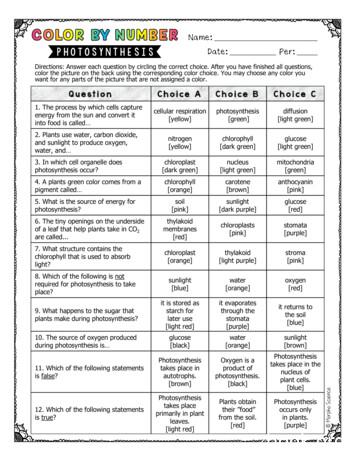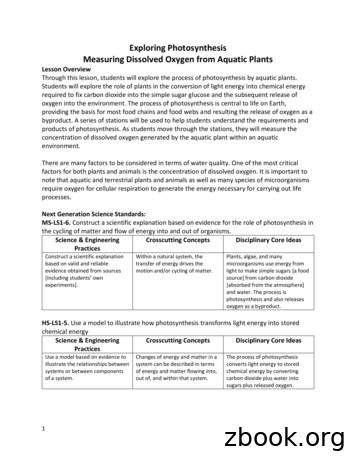Photosynthesis Helpful Handout
PhotosynthesisThe vast majority of energy found within any ecosystem on Earth originates from the Sun itselfand is transferred between organisms through complex food webs. Photosynthetic organismssuch as plants and algae form the basis of these webs by converting sunlight, water, and carbondioxide into usable energy. That energy can then be utilized by the photosynthetic organism,which itself may be consumed by other organisms for their own energy requirements. Thishandout will focus on explaining the steps involved in the most common version ofphotosynthesis, known as C3 photosynthesis.The purpose of the various anabolic redox reactions involved in photosynthesis is to generate amolecule of glyceraldehyde 3-phosphate (G3P), an important precursor to the carbohydrateglucose (C6H12O6), a form of sugar, and other types of biomolecules. For every two G3P made,one molecule of glucose can be created.The following equation and graphic provide a summary and general overview of the processesand reactants involved in photosynthesis:Source: OpenStax Biology. Download for free at 19a8aafbdd@8.56Provided by the Academic Center for Excellence1PhotosynthesisDecember 2019
Source: OpenStax Biology. Download for free at 19a8aafbdd@8.56Location of PhotosynthesisPhotosynthesis occurs within specialized organelles called chloroplasts that are located in thecells of green plant tissues. As shown in the following graphic, chloroplasts are abundant withinthe mesophyll, a type of leaf tissue found in between layers of epidermis and a waxy cuticlethat help to prevent the loss of water through evaporation. The stomata of each leaf allow forthe diffusion of CO2 and O2 to and from chloroplasts through the protective epidermis andcuticle.Source: Mader, S.S. & Windelspecht, M. (2016). Overview of photosynthesis. Biology (12th ed.). New York, NY: McGraw Hill Education.Provided by the Academic Center for Excellence2PhotosynthesisDecember 2019
Chloroplast StructureChloroplasts are membrane-bound organelles that are internally divided in a manner separatingand facilitating the reactions required for photosynthesis. Inside each chloroplast, the lightdependent reactions take place in membrane-bound sacs called thylakoids. A stack ofthylakoids may be referred to as a granum and multiple granum as grana. The internal space ofeach thylakoid is connected to adjacent thylakoids and may be referred to as either thethylakoid space or lumen. Surrounding the thylakoids is a fluid-filled space called the stroma,where light-independent reactions take place.Source: Mader, S.S. & Windelspecht, M. (2016). Overview of photosynthesis. Biology (12th ed.). New York, NY: McGraw Hill Education.Light-dependent ReactionsReactions requiring the presence of light are known as photosystems and take place within themembrane of the thylakoids. This is where the various pigments that absorb energy fromsunlight are located, usually some combination of chlorophylls and carotenoids. Photosystem II(PS II) is the initial phase of photosynthesis in which water molecules are broken down intohydrogen ions (H ), electrons (e-), and oxygen. The oxygen is released as a gas while the H ande- are retained. Then, e- in Photosystem II enter a reaction center in the thylakoid membranecontaining chlorophyll that captures energy from sunlight. The captured sunlight energy isabsorbed by e- in the reaction center, causing a jump to a high-energy state. This energy is thenreleased in stages as the e- travel through an ETC in the thylakoid membrane, causing H fromProvided by the Academic Center for Excellence3PhotosynthesisDecember 2019
the stroma to be concentrated in the lumen as part of the process. As the e- reaches the end ofthe ETC and moves on to be utilized in Photosystem I, the buildup of H establishes aconcentration gradient, thereby allowing chemiosmosis to take place through the enzyme ATPsynthase. As H flow through the internal structure of the enzyme and back into the stroma,ADP is joined with phosphate, thus forming ATP. This ATP will be used later during the Calvincycle.The image below shows, from left to right, the paths taken by e- and H through bothphotosystems after being split from water.Source: OpenStax Biology. Download for free at 19a8aafbdd@8.56Photosystem I (PS I) is the second phase of photosynthesis and begins with the e- fromPhotosystem II entering another chlorophyll reaction center. The e- are again energized bysunlight before moving from the reaction center to the enzyme NADP-reductase. There, theenzyme attaches the e- from Photosystem I and H from the stroma to the coenzyme NADP .With the addition of e- and H , the NADP is thereby reduced and becomes NADPH. With bothphotosystems now complete, the ATP and NADPH that were produced and positioned in thestroma are now ready to be used in the Calvin cycle.Provided by the Academic Center for Excellence4PhotosynthesisDecember 2019
Light-independent Reactions (Calvin cycle)The reactions of the Calvin cycle take place within the stroma and do not require sunlight. TheCalvin cycle begins with the intake of atmospheric CO2, to be combined with RuBP, forming thefirst in a series of metabolites that will eventually yield G3P. Each time the Calvin cycle iscompleted, one G3P molecule is retained for glucose production while the remaining five areconverted into exactly enough RuBP to restart the cycle. The steps of the cycle may be brokendown into the three phases listed below. Please note that C3, C5 and C6 refer to the number ofcarbon atoms present in each type of molecule during the Calvin cycle. For example, 3 RuBP C5indicates that there are 3 RuBP molecules present, each containing 5 carbon atoms.1. Carbon Fixation: As three molecules ofCO2 are brought into the stroma, threemolecules of five-carbon RuBP are present.These will each be combined by the enzymeRubisCO. This results in three molecules ofan unstable six-carbon intermediatemetabolite that immediately break downinto six three-carbon molecules of 3PG (3PGA in some sources).Provided by the Academic Center for Excellence5PhotosynthesisDecember 2019
2. Reduction: Six molecules ofATP and NADPH, createdearlier by the photosystems,are used to reduce the 3PGinto six molecules of BPG, theninto G3P. One molecule of G3Pexits the cycle to be used in theproduction of glucose at theend of the reduction phase.The exit of this three-carbonmolecule of G3P correspondsto the initial intake of the threecarbon atoms contained withinthe three molecules of CO2.3. Regeneration: The remaining fivemolecules of G3P are converted back intoRuBP by the application of three molecules ofATP. This results in exactly enough RuBP torestart the cycle.Provided by the Academic Center for Excellence6PhotosynthesisDecember 2019
The Calvin cycle must be completed twice in order for enough G3P to be available to produceone molecule of the sugar glucose. Thus, this process satisfies the equation for photosynthesisstated at the beginning of this handout: 6CO2 6H2O Sunlight C6H12O6 6O2.Provided by the Academic Center for Excellence7PhotosynthesisDecember 2019
photosynthesis, known as C. 3. photosynthesis. The purpose of the various anabolic redox reactions involved in photosynthesis is to generate a molecule of glyceraldehyde 3-phosphate (G3P), an important precursor to the carbohydrate glucose (C. 6. H. 12. O. 6), a form of sugar, and other types of
Photosynthesis takes place in autotrophs. [brown] Oxygen is a product of photosynthesis. [black] Photosynthesis takes place in the nucleus of plantcells. [blue] 12. Which of the followingstatements is true? Photosynthesis takes place primarily in plant leaves. [light red] Plants obtain their ”food” from the soil. [red] Photosynthesis .
photosynthesis 1/2-5/2 8/2 S1-5 Picnic Day 9/2-19/2 Lunar New Year Holiday photosynthesis 11A 4/6 Chapter 21 Photosynthesis o Basic concepts of photosynthesis o Requirements for photosynthesis o Site of The process of photosynthesis oPre Lesson Worksheet o Communication s
Photosynthesis Chapter 8 2 Photosynthesis Overview Energy for all life on Earth ultimately comes from photosynthesis. 6CO 2 12H 2O C 6H 12O 6 6H 2O 6O 2 Oxygenic photosynthesis is carried out by: cyanobacteria, 7 groups of algae, all land plants 3 Photosynthesis Overview Photosynt
UNIT 1 PHOTOSYNTHESIS AND RESPIRATION Photosynthesis is the process whereby plants use carbon dioxide, water and light energy in a series of chemical reactions to produce glucose (food). Photosynthesis Microorganisms Interactions and interdependencies Life and living Photosynthesis and respiration Photosynthesis Respiration
photosynthesis of an aquatic plant [Elodea]. The rate of photosynthesis can be determined by measuring the concentration of dissolved oxygen as the plant undergoes photosynthesis. There are multiple methods for measuring the rate of photosynthesis including: The uptake of CO 2 The production and release of O 2
In this live Gr 11 Life Sciences show we take a look at Photosynthesis. In this lesson we study the process of photosynthesis looking at the light and dark phases. We discuss the importance of photosynthesis as well as consider the effects of varying amou nts of light, carbon dioxide and temperature on the rate of photosynthesis.
LAB 8 – Photosynthesis . Objectives. 1. Assess CO 2 consumption and O 2 production during photosynthesis. 2. Analyze the role of light in photosynthesis. 3. Examine the effect of different wavelengths of visible light on photosynthesis. Introduction . In order to , organisms require a source of
automotive EMC requirements and detailed description of the design recommendations for meeting them. 3. Exploring the MPC5606E Reference board 6-layer design NOTE The main design considerations are described here using the example of the 6-layer Freescale automotive BroadR-Reach board. For best performance, it is critical to closely follow these design guidelines. NOTE Use this document in .























